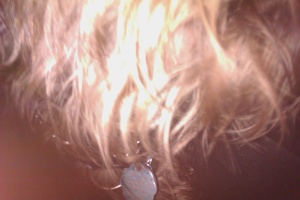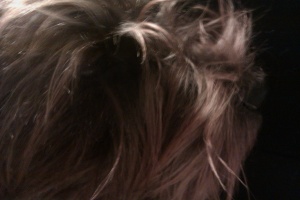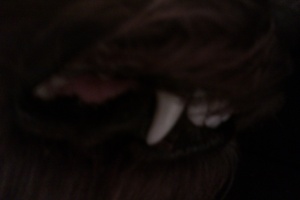Response to Picasso’s sculpture of a Cat
She’s pregnant, this cat
or just given birth. She’s muddy;
her tail's been broken.
Look at her neck, stiff
as a stanchion. Look at her compact
head; so ill-made for big thoughts
you fear her tail is pulling
her backwards. She isn’t curled
by contentment, or preying
with merciless grace, or cagily
sinuous. Still—
she is Cat. She disdains
opinion. You can tell
by the vainglorious shine
of her ears, as if she is listening to
an undivided convent
of cats chanting her name
lapping up her blessing
as she passes them. She has lived
fully; they have been holy.
Picasso stretched time between
sculptures; using his brush to pry apart
skulls, turning to his hands only when the Muse
purred to him. He was never trained
to mold clay or pour bronze but
what he made, he kept
close. They fattened
his household. Did he speak
to Cat? Attempt to straighten
her tail, even as she hissed? How do
you feed a Muse who doesn’t need
you? She’s given birth; he stirs mud.
----Sara Lewis Holmes (all rights reserved)
Thanks to Liz Garton Scanlon for discovering the intriguing Picasso sculptures, which provided the inspiration for this month's ekphrastic poetry challenge. (The Poetry Seven plans to respond to an image or piece of art every other month in 2016. I'm already researching which artist to choose when it's my turn...)
Here are the links to my Poetry Sisters' poems (each of us chose a Picasso sculpture from a select group, so there's some overlap in the inspiration images, but glorious uniqueness in the response!)
LizTanitaTriciaLauraAndi (taking a breather this month)
KellyMore about Picasso's sculptures.Poetry Friday is hosted today by one of the Poetry Seven's own, Tricia, at
The Miss Rumphius Effect.
Please forgive me while I stand on my soap box for a bit today.
 |
| I never wear shoes like this but maybe I should :0) |
It's that time of year again. Your kids have either already started back to school or they will be there shortly. Does your child's school still have an art program? More and more schools across the nation are eliminating arts and music programs. If they replace them with anything at all it is sometimes with pseudo art instruction performed by an unqualified classroom teacher.
That statement is not meant to disparage classroom teachers, it is just that they are not trained arts specialists. The major justification for ending arts programs is almost always budget. School districts are constantly complaining that they don't have a enough money for basic programs, so first on the chopping block is usually what administrators and parents see as the most extraneous and unnecessary programs- art and music.
Here are some of the common myths and justifications for deeming art as unnecessary and thereby eliminating it.
Every child is not a talented artist
Every child is not going to be an artist
Training children in the arts has no application to real world (job) success
Art is meant to help children "express themselves"
Here is what arts education really gives to your kids:
The number one most valuable thing that art education provides to your child:
It teaches them to THINK critically and innovate. It teaches them to TAKE RISKS and to see the BIG PICTURE.
Making art is not just about making pretty things or providing some slapdash approach to "self expression" devoid of rules and structure. There are rules in art- Elements and Principals of Design- which provides a framework for making good art and once understood, provides a vehicle for creating good art while breaking those rules and learning to innovate.
Art history provides a cultural framework and point of reference for history and innovation throughout time. Children without skill in creating art are still given an understanding of the cultural heritage of art, get exposed to great thinkers and artistic creators (ex. Picasso, Matisse) who broke from the mold of realistic art making to devise a new way of SEEING and creating.
Art is not always about the end product. The value of art education is more in the processes of creating art and learning about it than in the outcome of making a pretty picture.
Most other disciplines only work on finding right or wrong answers. There is no room for thinking out of the box or for creating a new paradigm. Children who are only being educated in these limiting disciplines will grow to only seek the correct (predetermined) answer, never being able to consider another option and will accept as irrefutable that which is spoon fed to him as fact.
We need to keep raising generations of Picasso's, Da Vinci's, Van Gogh's, Louise Nevelsons and even more Andy Warhol's, whose art was not just pictures of Campbell Soup cans, but a shrewd commentary on our massed produced society as a whole, a concept seen through an artists ability to view "the big picture."
 |
| Louise Nevelson |
 |
| Louise Nevelson- Royal Tide IV-Assemblage |
The world needs both kinds of thinkers, both right brain and left. Here is a perfect example:
Steve Wozniak, a left brain tech head computer guy who, left on his own would probably have had his own small company or gone to work for IBM or Microsoft or Oracle or any other computer giant out there at the time.
Steve Jobs, a hippy dippy, right brain college drop out with an understanding of business,training in art and a devoted sense and love for beauty and good design.
It is the combination of these two very different types of talents that brought us all of the elegant and beautiful Apple computer products which many of us enjoy and other companies try to emulate.
The marriage of these two divergent genius brains resulted in something of a lightening strike which created (in my opinion) one of the greatest tech companies ever.
 |
| Steve Jobs (standing) and Steve Wozniak (at keyboard) |
Is your kid going to be the next Steve Jobs or Picasso or Frida Kahlo? Maybe not. If given the benefit of a meaningful art education, what they can be is a well rounded human being who can think outside of the box, challenge the status quo, consider various answers to the same problem, create something from nothing, use the tools at hand in new ways and make cross cultural and historical connections.
Oh, and they may come home with a nice painting sometimes, too.
 |
| Frida and Me- © Karen O'Lone-Hahn |
The best non-fiction picture books of 2014, as picked by the editors and contributors of The Children’s Book Review.
By Meghann Wilhoite
American composer and self-proclaimed “bad boy of music” George Antheil was born today 114 years ago in Trenton, New Jersey. His most well-known piece is Ballet mècanique, which was premiered in Paris in 1926; like Stravinsky’s Rite of Spring, from which Antheil seems to have derived quite a bit of inspiration, the premiere resulted in audience outrage and a riot in the streets. The piece is scored for pianos and a number of percussion instruments, including airplane propellers.
Click here to view the embedded video.
Though he died at the age of 58, polymath Antheil managed to accomplish quite a bit in his relatively short life both in and outside the field of music. Here are some highlights:
- His name appears alongside the actress Hedy Lamarr’s on a patent, granted in 1942, for an early type of frequency hopping device, their invention for disrupting the intended course of radio-controlled German torpedoes.
- In 1937 he published a text on endocrinology called Every Man His Own Detective: A Study of Glandular Criminology. The book includes chapters on “How to read your newspaper” and “The glandular rogue’s gallery”.
- His music was championed by the likes of James Joyce, Ezra Pound, Sylvia Beach, W.B. Yeats, Erik Satie, and Pablo Picasso.
- Under the pseudonym Stacey Bishop, he wrote Death in the Dark, a detective novel edited by T.S. Eliot, the hero of which is based on Pound.
- After spending the majority of the 1920s and 30s in Europe, he settled in Hollywood and wrote dozens of film, television and radio scores, for directors such as Cecil B. DeMille and Fritz Lang (and with such titillating titles as “Zombies of Mora Tau” and “Panther Girl of the Kongo”).
- Last, but not least, here is Vincent Price narrating Antheil’s “To a Nightingale” with the composer himself on piano: George Antheil – Two Odes of John Keats – To A Nightingale: Vincent Price, narrator; George Antheil, piano
Meghann Wilhoite is an Associate Editor at Grove Music/Oxford Music Online, music blogger, and organist. Follow her on Twitter at @megwilhoite. Read her previous blog posts on Sibelius, the pipe organ, John Zorn, West Side Story, and other subjects.
Oxford Music Online is the gateway offering users the ability to access and cross-search multiple music reference resources in one location. With Grove Music Online as its cornerstone, Oxford Music Online also contains The Oxford Companion to Music, The Oxford Dictionary of Music, and The Encyclopedia of Popular Music.
Subscribe to the OUPblog via email or RSS.
Subscribe to only music articles on the OUPblog via email or RSS.
The post George Antheil, the bad boy of early twentieth century music appeared first on OUPblog.


This one is new to me. The Picasso Summer is a 1969 feature based on a Ray Bradbury short story. It includes an impressively lengthy animated sequence based on Picasso’s artwork that holds up on its own.
The animation is credited to Wes Herschensohn, who was a producer on the film and also an animation veteran. But this in-depth article about the film claims the animation was produced by John and Faith Hubley. Based on the style, it’s entirely plausible that the Hubleys provided the animation, though I’ve never heard of them being associated with the project. Whoever made this, it’s a unique interpretation of Picasso’s artwork into animation, and deserves more attention than it has received.
Today marks the end of the March “Whether” blogging challenge elicited by BlogHer network. It’s been an interesting month. You learned that someone could write something about writing every day for one month.
You learned how one writer actually thinks about writing, and what this writer has absorbed of some of the needs for this career. Above all, you learned that someone else loved words and their use in self-expression as much as you do. That’s quite a bit to take in about someone else.
Along the way, there was conversation about how writing affects and is affected by the outside world. No man is an island if he writes is a truism to remember. However isolated someone is, so long as he expresses himself in words, he communicates who he is to those who read those words.
Whatever the art form, the viewer/reader glimpses the internal workings of the artist. Picasso with his cubism and abstract renderings, Pollack with his splashes of wild color, Rodin and Russell with their sculptures all spoke to the viewer. Dale Chihuly dominates the gallery when he exhibits his glass marvels. Often the “feel” of a piece tells more about the artist than words ever could.
Photographers click shutters every day, capturing bits of our world and us, to exhibit in myriad ways, lest we forget who we really are and how we came to be where we are. Times change. Technology rides a wave that envelops all in its path. Art forms and their acolytes traipse along behind, ever in technology’s wake, hoping to stay abreast of trends that sweep the beach of daily life and tastes.
With the waning of this challenge comes a new one; one on poetry. Verse is as intimate as a writer can get to the reader. Secrets, long held, roll within the rhythm of a stanza. Emotion flails toward expression within limited space and precise words.
Nakedness of spirit calls to the reader, whether at the ending, the middle, or the beginning of a poem. Verse is the art of writing with glass, exposing inner turmoil, joys, hesitations, and inspirations, all that moves or halts the poet during life. It is raw for all its precision; blatant for all its subtlety; and limitless for all its restrictions.
That is the challenge taking place from tomorrow on to May 1, 2011. Within the span of those thirty days, you will find poems posted here that are written to specific writing prompts. Links to poetry sites will mark each post. Occasionally, other poets may be revealed to those either shy of verse or enthusiastic connoisseurs.
My hope is that you all can enjoy a stopover here each day.


 0 Comments on Whether Ending or Beginning as of 3/31/2012 9:02:00 PM
0 Comments on Whether Ending or Beginning as of 3/31/2012 9:02:00 PM



























 0 Comments on Puppicasso Predictions #31 as of 1/1/1900
0 Comments on Puppicasso Predictions #31 as of 1/1/1900














I think Puppi was put out by the Hello Kitty decor more than anything else!
All this Hello Kitty hate! (found this banner at the rink… where else?)